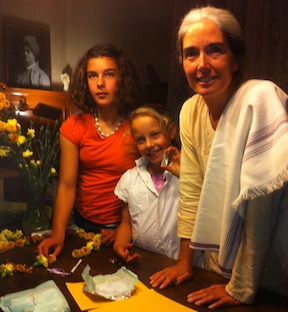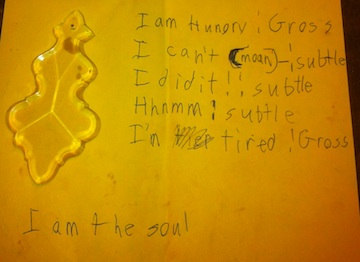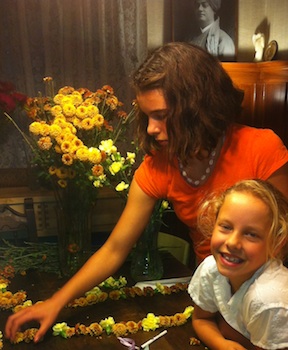How to tell the difference between the Self and the not-Self
by Bharati
Today is January 21, and again we are blessed with the presence of four beautiful children, ages 6 to 10 years, in the SRV San Francisco ashram. We have become a divine little group, all progressing at our own pace.
Each lesson always includes asana poses, breathing practice, meditation, a teaching, a discussion, contemplation, an activity, and then prasad.
Asanas & Meditation Pose:
The children know what to do now when they come for class at the ashram: enter into the upstairs classroom quietly, bow down to the altar, and gather in a circle. Then we began our asana, breathing, and meditation pose practices.
One of the mothers was able to join us, and her boys enjoyed her being there. Usually we have one or both of the mothers in attendance and they seem to glean a great deal from the class. Not only that, but they witness how their children blossom with each class they attend and are truly delighted by the outcome.
Meditation:
Now, time for meditation. The children made their way to the shrine room two floors below and calmly showed their mother the way. “This way Mom, I know where it is.”
We had a breakthrough today, an incredible breakthrough. Babaji lead us all into meditation and the children went in deep and remained still for the full 5 minutes. How nice it was sitting all together and meditating; having Babaji lead us was a treat. He is the Master teacher after all, and to have the Master teaching the children is a good thing. They are in good hands. Matthias went directly into meditation with no hesitation. The best ever! I am so happy for them. One can see them blossoming in front of one’s own eyes. “What were you thinking of Matthias?” Babaji asks. “I thought of nothing,” replied the 6 year-old boy.
 Teaching: What is Gross, Subtle, Causal?
Teaching: What is Gross, Subtle, Causal?
This is an in-depth teaching, as they all are, but it was approached with gentleness and simple sound examples for the children. Annapurna gave the children a clear crystal wrapped with 3 layers of different types of material. The outer layer represented the gross, the next layer represented the subtle, the innermost layer represented the causal, and the prize inside was the clear crystal representing the Atman (Soul). As they unfolded each layer Annapurna had them think on “What is our gross body?’ The physical body is our gross body. “What is our subtle body?” The mind and our thoughts and emotions, our dream senses and dream body is our subtle body. “What is our causal body?” When our gross body goes to sleep and when our subtle body/mind goes to sleep, we have a formless body that feels great peace and joy, but does not remember what happens there, only that we felt happy and peaceful. This is our causal body.
 Sebastian decided to take it upon himself and teach Annapurna what formless is, after she prompted him with the question, “What does formless mean?” His response: ”Formless is where no thought forms. Let me explain. It is a place where nothing can form. It is a place where it is not a place.” He had such an instant knowing. Hmmm.
Sebastian decided to take it upon himself and teach Annapurna what formless is, after she prompted him with the question, “What does formless mean?” His response: ”Formless is where no thought forms. Let me explain. It is a place where nothing can form. It is a place where it is not a place.” He had such an instant knowing. Hmmm.
When we took off all the layers we found the crystal, representing the Atman. “What is the Atman?” It is that part of us that sees the gross, the subtle and causal bodies all at the same time. It is our true “I.” When we say “I” it should mean the Atman. This means we have to be careful how we use “I.” Can the Atman be sick? No, the gross body gets sick, but the Atman never does. So when we say “I am sick,” what we really mean is that “My gross body is sick.” If we say, “I am angry,” we really mean “my subtle body/mind feels anger,” because the Atman is always peaceful and full of a happiness that never goes away. So, if we want to tell the truth, we have to be careful about how we use “I.”
 Activity:
Activity: Today we had two activities – Homework was assigned by Annapurna. But the children had no need to wait until they got home. Nope, they got right to work. Their minds were in motion and they just had to get it out. The assignment was to THINK on what are Gross, Subtle and Causal. In particular, every time they made an “I” statement, they were to think about which body they were talking about. For example, “I went to school” refers to the gross body. “I am sad about something” refers to the subtle body. Most of our “I” statements concern either the gross or subtle bodies. However, some of the kids decided to write it out and wanted further discussion on their work. So we all sat around and discussed Gross, Subtle, and Causal.
Today we had two activities – Homework was assigned by Annapurna. But the children had no need to wait until they got home. Nope, they got right to work. Their minds were in motion and they just had to get it out. The assignment was to THINK on what are Gross, Subtle and Causal. In particular, every time they made an “I” statement, they were to think about which body they were talking about. For example, “I went to school” refers to the gross body. “I am sad about something” refers to the subtle body. Most of our “I” statements concern either the gross or subtle bodies. However, some of the kids decided to write it out and wanted further discussion on their work. So we all sat around and discussed Gross, Subtle, and Causal.
 2nd activity: The children were so involved in their homework activity that they only had time to design the layout of the garland for the evening Puja in honor of Swamis’ Vivekananda and Brahmananda. They all gathered together and discussed how the design should look. They work well as a team, and they all agreed on a final BEAUTIFUL design.
2nd activity: The children were so involved in their homework activity that they only had time to design the layout of the garland for the evening Puja in honor of Swamis’ Vivekananda and Brahmananda. They all gathered together and discussed how the design should look. They work well as a team, and they all agreed on a final BEAUTIFUL design.
Encouragement: I encouraged one of the Mothers to meditate at home with her children. Create a beautiful area and have the children help you. Knowing them, they will know what to do.
